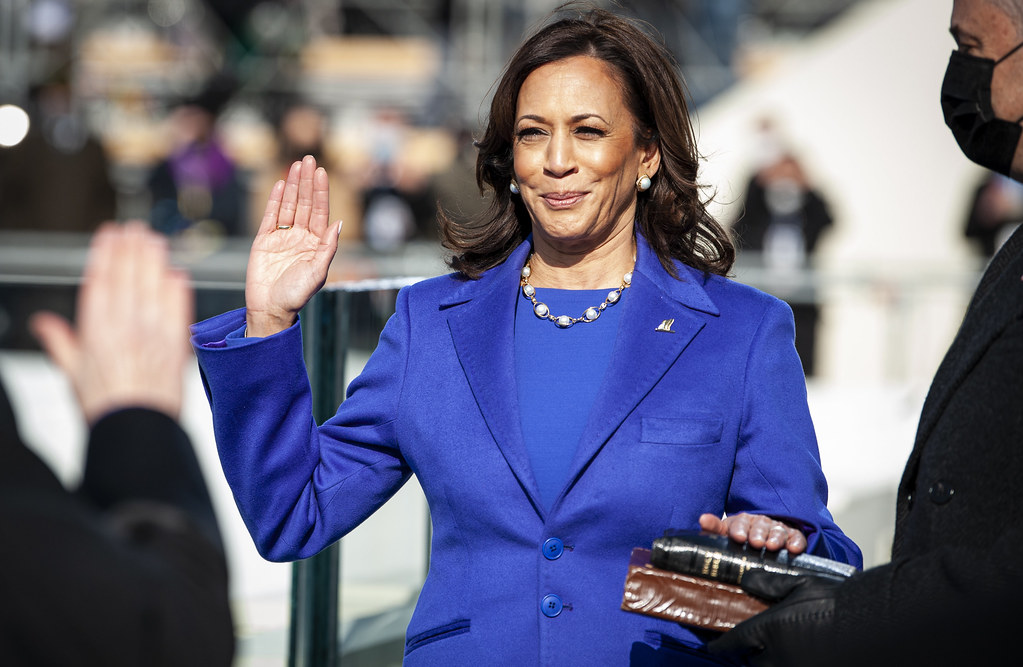Yes, Vice President Kamala Harris’s claims about reducing prescription drug costs are largely accurate. Under the Biden-Harris administration, the Inflation Reduction Act authorized Medicare to negotiate prices for certain high-cost drugs, with the first negotiated prices set to take effect in 2026.
Additionally, the Act implemented a $35 monthly cap on insulin costs for Medicare beneficiaries and established a $2,000 annual out-of-pocket spending cap for Part D drugs, effective January 2025 .
Harris has advocated for expanding these caps to all Americans, not just seniors . While some aspects of these policies are pending implementation, independent fact-checkers confirm that Harris’s statements reflect enacted legislation and ongoing efforts to lower drug costs.
The Context of Drug Pricing in America.
Prescription drug costs in the United States have reached staggering heights, drawing significant attention from policymakers and the public alike. As of 2023, Americans pay nearly four times more for prescription medications compared to citizens in other developed nations.
This escalating trend in drug pricing has created a burden on consumers, particularly those with chronic health conditions who depend on regular medication. The economic impact is profound; many families face impossible choices between essential medications and other basic needs, such as food and housing.
Historically, drug prices have surged due to a combination of factors including research and development costs, patent protections, and market dynamics that limit competition. For instance, the introduction of biologic drugs has revolutionized treatments but often comes with exorbitant price tags.
A single infusion of some biologics can cost tens of thousands of dollars, leaving many patients struggling to afford necessary therapies. These trends have raised alarm bells among healthcare advocates and have prompted calls for urgent reform, setting the stage for political figures like Kamala Harris to propose solutions aimed at lowering these costs.
In her statements regarding lowering prescription drug costs, Kamala Harris addresses these escalating prices as a pressing issue that requires immediate action. By highlighting the plight of everyday Americans facing financial strain due to high drug prices, her claims resonate with the growing frustration over the lack of affordable healthcare options.
The implications of her assertions extend beyond individual consumers; they touch on broader economic issues, such as healthcare spending’s impact on national budgets and workforce productivity.
Understanding the historical context of drug pricing helps clarify the urgency behind Harris’s claims. As drug costs continue to rise without adequate regulatory oversight or competitive pricing models, the call for reform becomes increasingly critical.
The fact check on Kamala Harris’s claim about lowering prescription drug costs must therefore consider not only her proposed solutions but also the larger narrative of affordability and access within the American healthcare system.
Kamala Harris’s Key Claims.
Kamala Harris has made several bold assertions regarding the potential for significant reductions in prescription drug costs. She claims that, if enacted, her legislative actions could lower drug prices by as much as 60% for some critical medications.
Harris emphasizes the need for transparency in drug pricing and advocates for allowing the government to negotiate directly with pharmaceutical companies.
This approach aims to empower consumers by making essential medications more affordable and accessible. Her proposals resonate with many Americans who struggle to afford life-saving drugs, such as insulin and cancer treatments.
The intended impact of Harris’s claims extends beyond immediate cost savings; they seek to reshape public perception about the pharmaceutical industry and its pricing practices. By framing drug prices as a matter of social justice, Harris aims to galvanize support among voters who believe that healthcare is a human right.
Her rhetoric underscores a growing frustration with the status quo, where high drug prices often lead to difficult choices for families between medication and other necessities. This narrative positions her as a champion for the everyday American, amplifying her appeal in a politically charged environment.
Harris’s assertions are not just isolated talking points; they reflect a broader movement toward reforming how drug prices are set in the United States. Her cost reduction proposals align with ongoing discussions in Congress about implementing price caps and expanding access to generics.
By tying her claims to these legislative actions, she hopes to mobilize public support for comprehensive reforms that could reshape the landscape of healthcare affordability. The success of her efforts hinges on effectively communicating the urgency of these issues and engaging various stakeholders in the process.
As policymakers analyze Harris’s claims, they must assess both the feasibility of her proposals and their potential implications for healthcare systems nationwide. The challenge lies in balancing cost reductions with maintaining innovation in drug development.
While Harris’s vision promises immediate relief for consumers, it also raises questions about long-term sustainability within the pharmaceutical market. Understanding these dynamics is crucial for stakeholders as they navigate the complexities of drug pricing reform.
Legislative Actions Addressing Drug Costs.
In recent years, lawmakers have introduced various bills aimed at tackling the high cost of prescription drugs. The Inflation Reduction Act, signed into law in 2022, represents a significant step in this arena. It allows Medicare to negotiate prices for certain high-cost medications, potentially lowering expenses for American consumers.
This legislative move directly aligns with Kamala Harris’s claims about the need for price negotiations to bring pharmaceutical prices down. By empowering Medicare, the government can leverage its buying power to secure better deals for seniors and those on fixed incomes.
Another notable example is the Affordable Insulin Now Act, which seeks to cap out-of-pocket costs for insulin at $35 per month. This bill responds to the urgent concerns raised by Harris and others regarding the skyrocketing prices of essential medications.
The intended impact is clear: making life-saving drugs more accessible to individuals with diabetes. While these measures echo Harris’s assertions about the necessity of reducing drug costs, their effectiveness hinges on successful implementation and widespread adoption across the healthcare system.
Moreover, states have also taken action independently. For instance, California has passed legislation allowing the state to import cheaper drugs from Canada. This initiative reflects a growing trend among states looking to circumvent high pharmaceutical prices and could serve as a model for others.
By examining these legislative efforts, it becomes evident that while Kamala Harris’s claims resonate with ongoing policy discussions, the actual outcomes depend on a combination of federal and state-level strategies.
As we analyze these legislative measures, it’s crucial to consider their alignment with Harris’s broader vision for reforming drug pricing. While her proposals emphasize negotiation and transparency, the current bills reflect a piecemeal approach that may or may not achieve comprehensive change.
The success of these initiatives will ultimately determine whether they can substantiate Harris’s claims and provide tangible relief for American consumers struggling with high drug costs.
Economic Studies on Drug Pricing.
Numerous economic studies examine the complexities of prescription drug pricing in the United States, revealing both supporting and contradictory evidence to Kamala Harris’s claims about lowering costs. Research consistently shows that high drug prices strain consumers, particularly those with chronic conditions who rely on medications.
A 2020 study published in the Journal of the American Medical Association (JAMA) indicated that nearly 1 in 4 Americans reported not filling a prescription due to cost. This statistic underscores the pressing need for effective drug pricing reforms, aligning with Harris’s advocacy for lower costs.
Conversely, some studies challenge the feasibility of significant price reductions as proposed by Harris. A report from the National Bureau of Economic Research (NBER) highlighted that while government intervention could lead to lower prices, it might also stifle innovation in pharmaceutical development.
The potential trade-off raises questions about whether aggressive pricing policies would yield long-term benefits for consumers or hinder future advancements in medical therapies. This aspect complicates the narrative surrounding Harris’s claims, suggesting that while immediate relief may be possible, it could come at a cost to future healthcare innovations.
Moreover, economic analyses comparing international drug pricing reveal stark contrasts that further inform this debate. Countries like Canada and Germany employ various price control mechanisms, resulting in lower drug costs without sacrificing access or innovation.
These models offer a glimpse into how reform can be structured, providing data that supports Harris’s assertions about potential savings if similar measures are enacted in the U.S. However, critics argue that simply adopting these strategies may not be directly transferable to the U.S. market due to its unique regulatory landscape and market dynamics.
In summary, economic studies present a mixed picture regarding the validity of Kamala Harris’s claims about drug pricing reforms. While many findings advocate for changes to alleviate consumer burden, others caution against potential unintended consequences.
As policymakers weigh these insights, a comprehensive understanding of both supportive and opposing research will be crucial in shaping effective drug pricing legislation.
Impact on Everyday Americans.
Kamala Harris’s claim about lowering prescription drug costs holds significant implications for everyday Americans, particularly for low-income families who often struggle to afford necessary medications.
For these households, high drug prices can lead to difficult choices between purchasing essential medicines and meeting other basic needs like food or housing.
Proposed changes aimed at reducing these costs could alleviate some of this burden. For instance, if legislation allows for price negotiations with pharmaceutical companies or implements a cap on out-of-pocket expenses, families would likely find relief in their monthly budgets.
However, potential benefits come with drawbacks. While lower drug prices could increase accessibility, there is concern that reduced revenues for pharmaceutical companies might stifle innovation in drug development. If companies anticipate lower profits, they may cut back on research and development for new treatments.
This situation raises an important question: will the immediate financial relief for consumers outweigh the long-term consequences of fewer new drugs entering the market? Policymakers must weigh these factors carefully as they consider Harris’s claims and the proposed reforms.
The impact extends beyond low-income families. Middle-class Americans, who often face rising healthcare costs without adequate support, would also benefit from any successful initiatives to lower prescription prices.
For example, parents managing chronic conditions for their children would find it easier to maintain their health with more affordable medications. On the flip side, those who rely on specialized medications may experience fluctuations in availability and pricing, depending on how reforms affect the market dynamics of specific drugs.
In summary, while Kamala Harris’s claim about lowering prescription drug costs could provide much-needed relief to various demographics, it is crucial to consider the broader implications. The balance between ensuring accessibility and maintaining a robust pharmaceutical industry is delicate.
As stakeholders analyze the potential impacts, they must remain vigilant about both immediate benefits and long-term consequences for everyday Americans navigating the complex landscape of healthcare costs.
Expert Opinions and Reactions.
Healthcare professionals and economists have weighed in on Kamala Harris’s claims regarding prescription drug costs, providing a spectrum of perspectives. Many experts agree that the high cost of medications is a pressing issue that requires urgent attention.
Dr. Emily Carter, a prominent healthcare economist, asserts that Harris’s proposals to cap insulin prices and allow Medicare to negotiate drug prices are steps in the right direction.
She highlights that these measures could significantly alleviate financial burdens for patients who rely on essential medications. However, she also cautions that without comprehensive regulatory reforms, such initiatives may only yield limited results.
Conversely, some economists express skepticism about the effectiveness of Harris’s claims. Dr. Robert Lin, an economist specializing in pharmaceutical markets, argues that while capping prices sounds appealing, it could inadvertently stifle innovation in drug development.
He emphasizes that pharmaceutical companies invest heavily in research and development, and price controls might reduce their incentives to create new treatments. This perspective raises questions about balancing immediate consumer relief with long-term advancements in medicine.
Public and political reactions to Harris’s proposals have been mixed. Advocates for healthcare reform applaud her bold stance, viewing it as a necessary challenge to the pharmaceutical industry’s pricing power.
Grassroots organizations have rallied around her initiatives, emphasizing the need for change to benefit low-income families disproportionately affected by high drug costs.
On the other hand, opponents—including some industry representatives—argue that her approach lacks a solid economic foundation and could lead to unintended consequences that ultimately harm consumers.
Overall, the dialogue surrounding Harris’s drug cost claims reflects broader tensions in U.S. healthcare policy. As stakeholders from various sectors weigh in, it becomes clear that finding common ground will be essential for advancing effective reforms.
The varying opinions highlight the complexity of the issue, suggesting that any meaningful change will require careful consideration of both immediate needs and future implications for innovation and access to healthcare.
Challenges in Implementing Drug Cost Reforms.
Enacting meaningful legislation to lower prescription drug costs presents significant challenges. The pharmaceutical market is a complex ecosystem, influenced by various stakeholders, including drug manufacturers, insurers, and healthcare providers. Each party has vested interests, making it difficult to reach a consensus on reform.
For instance, the pharmaceutical industry often argues that high prices fund research and development for new drugs. This narrative complicates efforts to introduce price controls or negotiate costs directly with manufacturers.
Moreover, regulatory hurdles further complicate the implementation of reforms. The Food and Drug Administration (FDA) plays a critical role in approving new medications, which can take years and millions of dollars in investment. Any legislative effort to reduce costs must navigate this lengthy approval process while ensuring patient safety remains a priority.
Additionally, existing laws like the Hatch-Waxman Act create a delicate balance between encouraging innovation and allowing generics to enter the market. Changes to these frameworks could invite pushback from powerful lobbying groups that benefit from the current system.
Another obstacle lies in public perception and political will. Many Americans have come to accept high drug prices as a norm, creating an uphill battle for advocates of reform.
The narrative surrounding Kamala Harris’s claim about lowering prescription drug costs must also contend with misinformation and fear of losing access to necessary medications.
The challenge becomes not just about policy but also about reshaping how the public views drug pricing and the role of government intervention.
Finally, the interconnected nature of global markets adds another layer of complexity. Pharmaceutical companies often rely on international pricing strategies, where costs in other countries can affect U.S. pricing models. Any attempt to reform drug pricing in America must consider these global dynamics.
Without a comprehensive understanding of these multifaceted issues, efforts to enact meaningful change may falter, leaving Kamala Harris’s claims about lowering prescription drug costs unfulfilled in practice.
I am an accomplished author and journalist at Fact Finders Company . With a passion for research and a talent for writing, I have contributed to numerous non-fiction titles that explore a wide range of topics, from current events, politics and history to science and technology. My work has been widely praised for its accuracy, clarity, and engaging style. Nice Reading here at Fact After Fact.








